Are you trying to learn more about NFT Memberships?
Perhaps your company or brand has finally realized that they need to take NFTs seriously and now you’re trying to get up to speed on how they work?
Well, I’ve got good news for you because strong brands are the ones who stand to gain the most from NFT memberships if they implement them correctly.
In this guide, you’ll learn how NFT memberships work and why they are every marketer’s dream come true.
Let’s get right to it.
Key Points (tl;dr)
- While existing forms of membership business models tend to link access to the product or service to a specific individual and their identity, NFT memberships are detached from people. Instead, access is granted to anyone who holds the correct NFT in their crypto wallet. The NFT effectively becomes a “key”.
- This process is often referred to as “token gating”. The gates remain closed until the user can demonstrate that he/she holds a particular token that grants these access rights. Token gating is considerably more effective than account-based authentication because users are unlikely to share a wallet.
- For many companies, especially consumer product brands, NFT memberships are a great opportunity to create unique fan experiences as part of an existing or enhanced loyalty program.
- By linking benefits to an NFT, brands and holders have fully aligned incentives. Holders want the brand to succeed because it will likely increase the value of their token. Brands are also incentivized to continue to provide utility and benefits to token holders because otherwise, the price will fall, resulting in reputational damage.
- While many of the same mechanics should be achieved without NFTs, what makes them different is the fact that they are interoperable. For the first time in history, brands are able to target and engage with their most loyal fans across many platforms using a single identifier and without having to collect personal information.
For more details on some of the concepts your brand can implement with NFTs, PLEASE SCROLL FURTHER DOWN THE ARTICLE.
Like this content? Then share it!
NFT Memberships: What Brands Need to Know in 2023
www.tokenizedhq.com
Here’s the answer. Great article by @ChrisHeidorn right here: https://tokenizedhq.com/nft-memberships/
What Are NFT Memberships?
NFT memberships use non-fungible tokens as the primary way of authenticating members and granting them access to products, services, and other benefits. The membership is not linked to recurring payments made by a specific person or account. Instead, the NFT itself acts as the “key” to the membership and can be sold and transferred to another wallet.
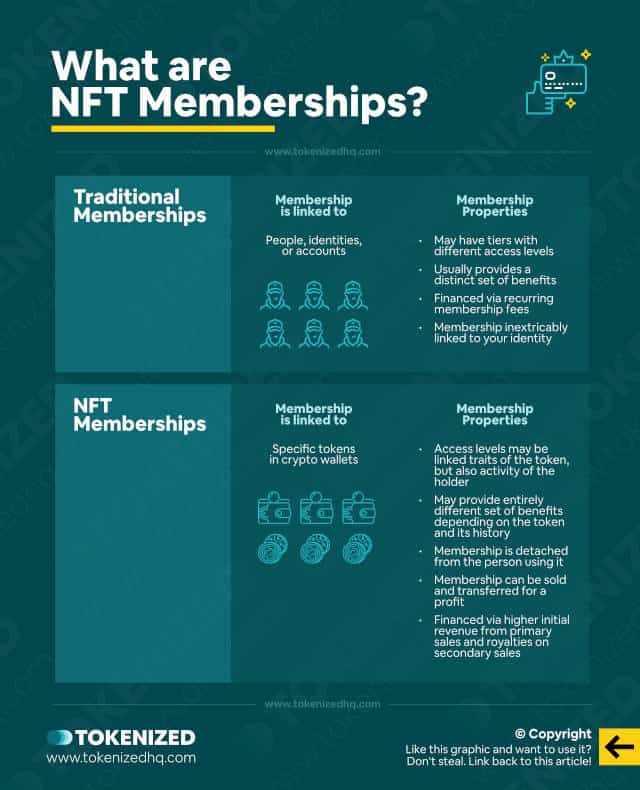
Let me guess, you’re probably asking yourself “What on earth is an NFT membership?”.
NFTs have been one of the hottest topics in the past year and generated their fair share of controversy as well.
A lot of it is due to the fact that very few people actually understand what NFTs are.
Their knowledge is primarily based on skimming the headlines of media outlets that make money by generating outrage.
People hear “NFTs” and “Blockchain” which makes them think of Bitcoin and since Bitcoin is “bad”, they also believe that NFTs must be bad.
Simple enough, right?
Well no, of course not.
Anyway, in today’s business paradigm most marketers are aware of 2 forms of membership.
- Exclusive Memberships (Paid): There are varying degrees of exclusive memberships. They can be as simple as a gym membership (assuming it’s a trendy gym) and as complex as a country club membership that also has a restrictive selection process.
- Inclusive Memberships (Free-To-Join): The most common form of membership used by brands is free for everyone to join and the most obvious example of such a membership is loyalty programs. Anyone can join and a few basic perks are for free but everything else is mostly performance-based (i.e. the most you spend and engage, the most your get).
So how do NFT memberships fit into this picture?
Well, NFTs are not so much a “type” of membership, but rather a technology that enables brands to create enhanced versions of existing membership models.
NFTs essentially act as “keys” that are used to authenticate the holder and confirm that he/she has the right to access a certain benefit of the membership.
I know this all sounds a bit esoteric but we’ll dive into some of the technical details in the section below.
How Do NFT Memberships Work?
An NFT membership uses a process known as “token gating” to restrict specific types of content, events, communities, services, and other benefits to people who own a particular NFT. Token gating is considerably more effective than a user account because accounts are easily shared while crypto wallets are unlikely to be shared between people.
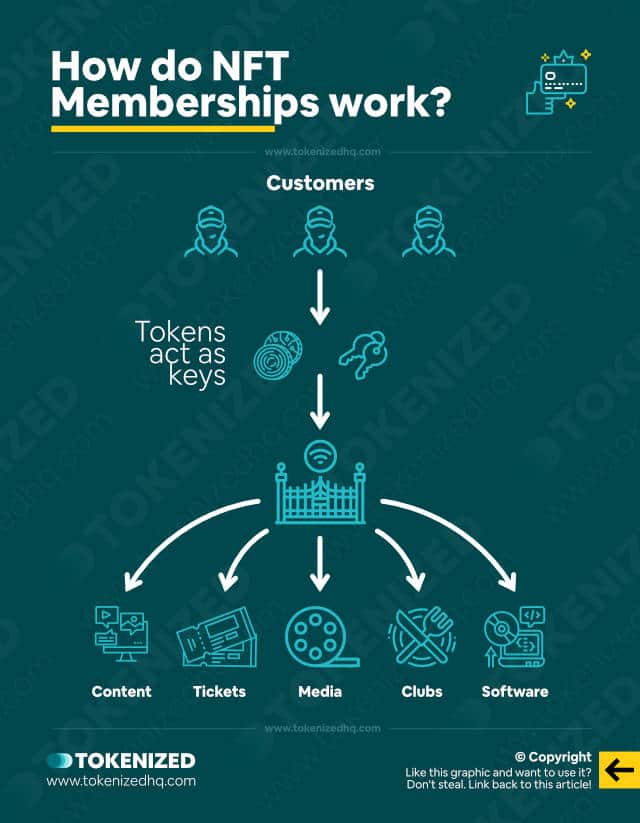
NFT memberships are powered by a process known as token gating.
Holders of a specific “token” are able to unlock the “gate” to a specific event, item, product, service, piece of content, or section of a site.
So, for example, let’s say I own an exclusive NFT from Time Magazine that gives me unlimited access to all paid content on their website.
When I visit a restricted piece of content, I will most likely be confronted with some sort of paywall.
In the current paradigm, I would log into my Time Magazine account and gain access to the article.
In the new Web3 paradigm, I would connect my crypto wallet to the Time website.
The site would then verify that my wallet contains the exclusive NFT and unlock the article.
If you’re a skeptic, your response to this would probably be something like “Sounds like a complicated solution to a simple problem”.
And you’d be absolutely right with that assumption if it weren’t for an important detail: Interoperability.
We’ll touch upon that later in this article but bear with me here.
As you may have already guessed, the mechanism of token gating can be used to unlock just about anything:
- Access to Content (Articles, Video, Audio)
- Links to Restricted Areas (Links, Member Areas)
- Tickets (Access to Events)
- Venues (Restaurants, Stadium, Theaters, Stores)
- Software (Tools, Operating Systems)
- Discounts
The possibilities are endless and also not merely limited to something as simple as “show me your token and I’ll let you in”.
There are lots of innovative ways in which token gating enables brands to create engaging experiences that can even involve more than one person.
Personally, I believe that many existing subscription products will shift towards NFT subscriptions.
This is especially relevant for Software-as-a-Service products, but we’ll save that discussion for another day.
If you’re interested in learning more about token-gated access, check out our dedicated article on token gating.
Why Brands Should Take NFT Memberships Seriously
NFT memberships represent a unique opportunity to curate exclusive brand experiences for their most engaged and loyal fans. Loyalty programs can be taken to the next level, unlocking value for holders across the full spectrum of venues and fully aligning the incentives of brands and their customers by sharing the upside.
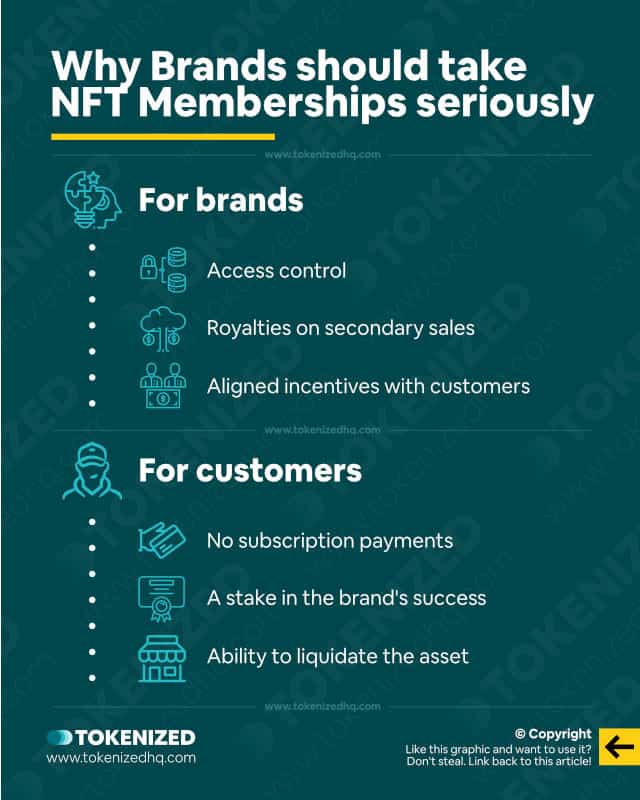
In the past years, it was relatively easy to look at the cryptocurrency industry and dismiss Blockchain technology as another useless hype.
Not only did unknowing speculators lose millions, but Bitcoin also became the climate movement’s public enemy number one.
And the fact that the financial industry was amongst the first to see the potential benefits made many even more skeptical.
People are so consumed by their hate for all things “Blockchain” that they fail to see opportunity.
But anyone who’s been paying attention has surely noticed that something is different this time around.
The mere fact that you are reading this article and probably work for a fairly big brand already says it all.
Many of the most successful consumer brands have understood that NFTs represent a massive opportunity, not only financially but also in terms of creating brand loyalty.
Let’s look at how NFTs have the potential to completely change the game and not only benefit brands but also their loyal fans.
Avoid Commoditization
The commoditization of a product is the death of a brand.
The more a market becomes commoditized, the more difficult it is for a brand to charge a higher price.
Any serious brand will constantly invest in developing new products and services and running marketing campaigns that help differentiate it from the mass market.
NFTs, as part of a customer loyalty strategy, enable brands to inject elements of scarcity into memberships.
Imagine releasing a set of 1,000 NFTs as part of an exclusive NFT membership.
Instead of making all 1,000 NFTs the same, you can give them different traits with different levels of scarcity.
Certain traits may unlock different levels of access or other benefits within the membership.
Furthermore, depending on how extensively the NFT is used, it might unlock additional access levels and benefits.
So all of a sudden, you have various different factors that influence the perceived value of that particular token.
And because the NFT is the “key” that unlocks access to that part of the NFT membership, it becomes an asset that can appreciate in value.
Incentivize Holders & Brands
In the example I just described, the NFT became more valuable because its owner was an engaged and active member of the community.
One of the biggest challenges that brands face is the activation of their fan base.
Not everyone who “likes” a brand is necessarily a “huge fan”.
So while a brand’s biggest fans are fairly easy to engage, the next tier of customers might need more incentives.
If you hold a particular NFT membership and know that it will become more valuable if you use it and engage with the brand, you are more likely to do so.
Serious fans might even want to “upgrade” their NFT membership by swapping it for rare traits, simply because it provides different levels of access.
The brand directly benefits from such trading activity because it earns a royalty on every trade.
At the same time, brands are strongly incentivized to continue providing utility and benefits to their NFT holders.
If they don’t, the price of their NFT membership will fall.
Not only is it a bad look for the brand but it also reduces the value of their royalties.
Holders and brands are equally incentivized and share in the upside if the brand is successful.
Memberships Become Assets
Since the access of an NFT membership is tied to the NFT itself, holders effectively “own” their membership.
The NFT becomes an asset that has its own market value and unlike a traditional membership that is linked to a person or account, an NFT can easily be sold and transferred to another person.
This is a crucial aspect because the holders can only share in the upside if they have the option to sell it.
Your instinctive reaction might be that this isn’t good for the brand, but that assumption is wrong.
Sure, selling pressure will reduce the price of the NFT membership, but that puts brands under pressure to provide utility and benefits.
One could also argue that when an NFT membership changes hands, a less engaged fan is being replaced by someone who is more engaged.
And to top it all off, every trade generates revenue in the form of royalties.
NFT Memberships Are a Marketers Dream Come True
Since NFTs live on the public blockchain they are interoperable across existing and future platforms. You can authenticate the very same NFT holder on your website, on Instagram, on TikTok, or in real life. This opens up endless possibilities for brands to collaborate with other businesses and engage with their members without requiring their personal details.
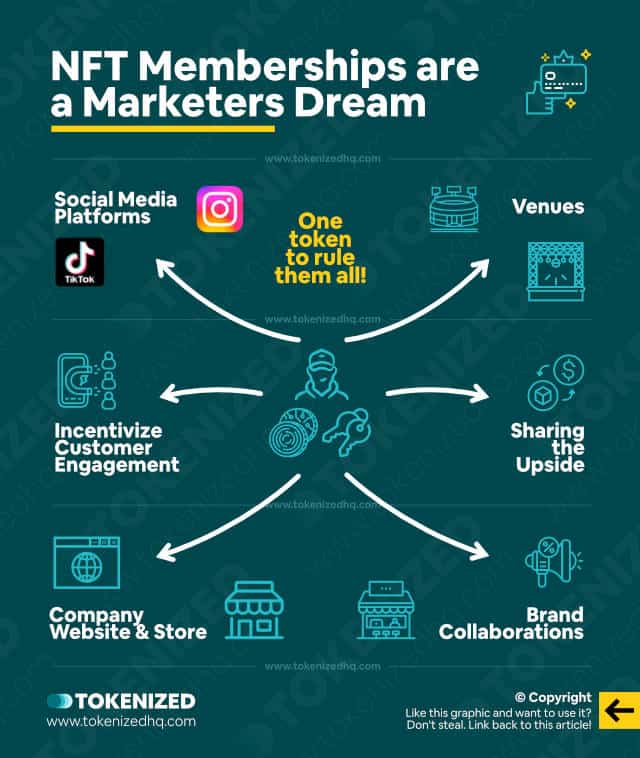
Despite all of what I’ve said so far, some of you might still be wondering why you need NFTs to do all this.
And yes, theoretically, you could replicate many of the aspects I’ve mentioned using today’s existing technology.
However, there is one thing that is close to impossible to achieve: Interoperability.
You might remember that I mentioned this term earlier in the article.
Well, now I’m going to explain why interoperability matters, especially if you’re a marketer.
NFT memberships are interoperable because they allow brands to establish a holder’s “access rights” independently from the platform that is being used.
You can authenticate a holder on a website that you control, but you’ll eventually be able to do the same on social media platforms as well.
You can also verify their token at a real-life event or anywhere else for that matter.
Do you realize how easy it becomes to launch a collaborative marketing campaign between 2 different companies?
And you can do all that without invading their privacy.
Who they are and where they live almost becomes irrelevant because what counts is the NFT.
Today, linking members of your loyalty program across various different platforms is next to impossible.
There are entire industries that revolve around helping corporations manage customer identities across different legal entities.
All of that becomes irrelevant once you can target specific holders of a token rather than their email addresses.
Taking the earlier example of a 1,000 NFT membership collection, the scarcity of each NFT allows you to cluster them into tiers.
The rarest and most expensive NFTs are likely to be owned by people who have higher spending power.
On the other hand, NFTs with a strong history of activity and engagement are probably some of the most loyal fans the brand has.
It doesn’t matter what the holder’s name is or where they live (for the most part), what counts is how engaged they are.
Optimizing Revenue with NFT Memberships
NFT memberships can be used to tap into new market segments that hold considerable spending power. Primary NFT sales can generate short-term revenue that is similar to so-called “lifetime deals” but also generate long-term revenue from royalties on secondary sales.
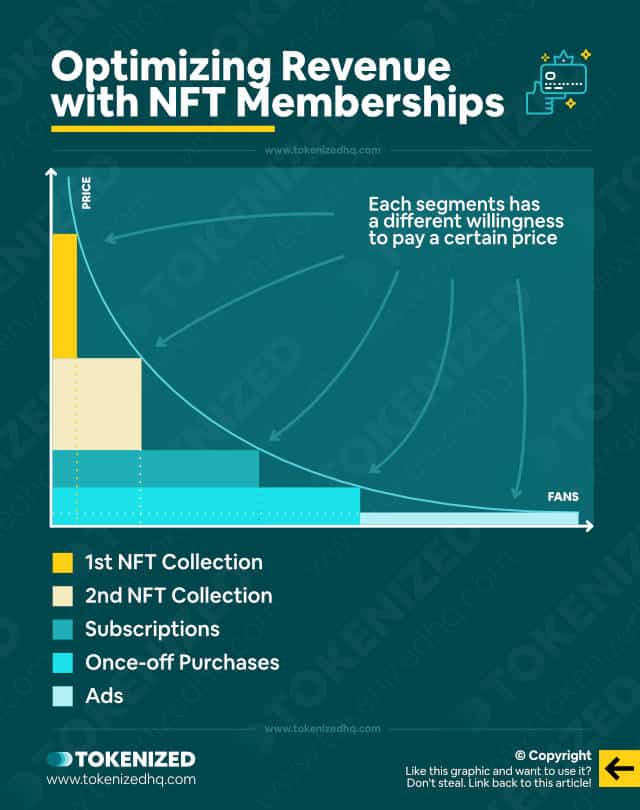
In the end, the objective for brands is to create more meaningful customer experiences and also make more money along the way.
Traditionally, companies could choose between 3 different forms of monetization:
- Ads
- Once-off Payments (limited support)
- Subscriptions (ongoing support)
Each model comes with different strengths and weaknesses.
And while most businesses will not necessarily use all 3 of them, many use a combination of 2.
Broadly speaking, each model addresses a different segment of a brand’s customer base with a different willingness to pay.
NFT memberships introduce an entirely new model that addresses a highly engaged customer segment with a very high willingness to pay.
Theoretically, this segment could be split into further sub-segments with additional NFT collections.
The beauty of the NFT membership is that it generates once-off revenue that is similar to a lifetime membership plan but also has the potential to generate ongoing revenue through trading activity.
To give you an idea of the type of money we are talking about, Nike has generated a mind-boggling $185 million in revenue from its NFT collections in 2021 ($93m from primary sales and $92m from secondary sales).
Examples of NFT Membership Concepts for Marketers
The following list of concepts is intentionally “vague”.
My primary objective is to give provide you with some food for thought on how NFTs can be implemented into memberships in innovative ways.
Not everything has to be as basic as using an NFT to unlock a member area or unlocking an article on a website.
It’s time to let your imagination go wild:
- Premium Features: You’re a car manufacturer and holders of an NFT can unlock exclusive features.
- Early Access: You produce movies or other forms of video content and holders get access to an early screening.
- Participation: Holders of your NFT can have their PFP character star in your upcoming TV show.
- Revenue Share: You license content and holders of your NFT earn a share of the royalties.
- Team Staking: Several holders band together and stake their NFTs to unlock perks that a solo holder could not.
- Performance-based: The more you use an NFT membership, the more access you get. The NFT maintains its access level even after it is sold.
In most cases, innovating with NFTs will require deep knowledge of your specific sector and customer behavior.
Some models that work for specific use cases may not be suitable for others.
However, once you understand the paradigm shift, the opportunities are literally endless.
Conclusion
NFT memberships are an entirely new way of monetizing a customer base.
Not only can they help you address untapped segments of the market, but they also provide a unique opportunity to create more meaningful relationships with existing customers.
If you are an established company with strong brand loyalty, then NFTs are definitely something you should be exploring.
Here at Tokenized, we want to help you learn as much as possible about the coming NFT revolution. We help you navigate this fascinating new world of non-fungible tokens and show you how you can integrate tokenization into your own business.



